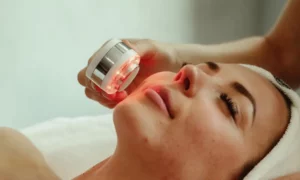Navigating the complicated journey of menopause requires a comprehensive approach, and women worldwide are increasingly turning to innovative solutions. Among these, red light therapy emerges as a beacon of hope, offering natural relief from the challenges that accompany this significant life transition. In this article, we delve into the science behind red light therapy and explore how it eases menopausal discomfort. Join us as we uncover the transformative potential of red light therapy and empower women to embrace a brighter, more comfortable menopausal experience.
Contents
Understanding Red Light Therapy 
Red light therapy, also known as low-level laser therapy (LLLT) or photobiomodulation (PBM), is a form of non-invasive therapy that uses low-level red or near-infrared light to stimulate cellular function. This therapeutic approach has gained popularity for its potential benefits across various health and cosmetic applications. Here are key points about red light therapy:
- Wavelength Range: Red light therapy typically utilizes light in the red (630-700 nm) or near-infrared (700-850 nm) wavelength range. These wavelengths penetrate the skin to reach cells and tissues.
- Cellular Stimulation: The red and near-infrared light energy is absorbed by the mitochondria, the energy-producing structures within cells. This absorption can enhance cellular function and promote various biological responses.
- ATP Production: Red light therapy is believed to stimulate the production of adenosine triphosphate (ATP), a molecule that stores and releases energy in cells. Increased ATP production in the body is believed to support cellular activities and metabolism.
- Benefits for Skin Health: Red light therapy is used for skin-related purposes, including promoting collagen production, reducing wrinkles and fine lines, and improving overall skin tone and texture.
- Wound Healing: The therapy may accelerate wound healing by enhancing cellular repair mechanisms and reducing inflammation. Clinical settings use it for wound care and post-surgical recovery.
- Muscle Recovery: Athletes and fitness enthusiasts use red light therapy to potentially reduce muscle soreness and promote faster recovery after intense exercise.
- Joint Pain and Inflammation: Some studies suggest that red light therapy may have anti-inflammatory effects, making it a potential option for managing joint pain and inflammation associated with conditions like arthritis.
- Hair Growth: Red light therapy is explored as a treatment for hair loss or thinning. It stimulates hair follicles and promote hair regrowth.
Menopause And Its Challenges
Menopause is a natural biological process that marks the end of a woman’s reproductive years. It is characterized by a decline in the production of hormones like estrogen and progesterone, occurs typically around the age of 45 to 55, although the timing can vary. The cessation of menstruation is defined, as leading to various physical and emotional changes. Key Aspects of Menopause:
- Perimenopause
The transitional phase leading up to menopause is known as perimenopause. It can start several years before menopause, during which hormone levels fluctuate, and women may experience irregular periods and various symptoms. - Cessation of Menstruation
Menopause is officially declared when a woman has not had a menstrual period for 12 consecutive months. This marks the end of her reproductive capacity. - Hormonal Changes
Estrogen and progesterone levels decline during menopause. These hormonal shifts contribute to various physical and emotional symptoms. - Challenges of Menopause
- Hot Flashes and Night Sweats: Sudden and intense feelings of heat, often accompanied by sweating, can disrupt daily activities and sleep.
- Vaginal Dryness: Reduced estrogen levels may lead to vaginal dryness, causing discomfort and impacting sexual health.
- Sleep Disturbances: Changes in hormone levels can contribute to insomnia and disturbed sleep patterns.
- Mood Swings
Fluctuating hormones can contribute to mood swings, irritability, and increased emotional sensitivity. - Depression and Anxiety
Some women may experience symptoms of depression or anxiety during menopause, which can be influenced by hormonal changes and life transitions. - Osteoporosis
The decline in estrogen levels during menopause is associated with an increased risk of osteoporosis, a condition characterized by weakened and brittle bones. - Sexual Health
- Loss of Libido: Changes in hormonal levels and physical symptoms like vaginal dryness may contribute to a decrease in sexual desire.
- Painful Intercourse: Vaginal dryness can make sexual intercourse uncomfortable or painful for some women.
Red Light Therapy And Menopause Connection 
The potential applications of red light therapy in addressing some symptoms associated with the menopausal transition connect red light therapy and menopause. Here is an overview of how red light therapy may be linked to menopause:
Hot Flashes and Night Sweats
- Connection: Researchers are exploring red light therapy as a non-pharmacological approach to managing vasomotor symptoms like hot flashes and night sweats, common during menopause.
- Mechanism: The therapy may influence blood flow and vascular function, potentially helping to regulate the body’s temperature control mechanisms.
Skin Health
- Connection: Menopausal hormonal changes often lead to a reduction in collagen production and skin elasticity, contributing to wrinkles and dryness.
- Mechanism: Red light therapy is used for its potential to stimulate collagen production, improve skin tone, and reduce the appearance of fine lines, providing cosmetic benefits during and after menopause.
Sleep Disturbances
- Connection: Menopausal women may experience sleep disturbances and red light therapy’s impact on circadian rhythms and melatonin production may influence sleep patterns.
- Mechanism: Exposure to red light in the evening may help regulate the sleep-wake cycle, potentially improving sleep quality.
Mood and Mental Well-being
- Connection: Hormonal fluctuations during menopause can contribute to mood swings, anxiety, and irritability.
- Mechanism: Researchers are investigating red light therapy for its potential to exert positive effects on mood and mental well-being, possibly through its impact on neurotransmitters and neuroplasticity.
Bone Health
- Connection: Menopausal women are at an increased risk of osteoporosis due to hormonal changes affecting bone density.
- Mechanism: While not a direct substitute for other interventions, red light therapy may contribute to bone health by promoting cellular activities involved in bone regeneration and remodelling.
Joint Pain and Inflammation
- Connection: Joint pain and inflammation may be exacerbated during menopause.
- Mechanism: Red light therapy is known for its potential anti-inflammatory effects, and it may help manage joint pain associated with menopausal changes.
Hormonal Balance
- Connection: Red light therapy is being studied for its influence on hormonal balance, including the potential to modulate estrogen and other hormones.
- Mechanism: Establishing clear mechanisms requires more research, but the therapy may play a role in hormonal regulation through its impact on the endocrine system.
It’s important to note that while there is growing interest in the potential benefits of red light therapy for menopausal symptoms, research in this area is still evolving. Individuals considering red light therapy for menopausal symptom management should consult with healthcare professionals to ensure safety and appropriateness for their specific circumstances. View red light therapy as a complementary approach and not a replacement for evidence-based medical interventions when needed.
Choosing The Right Red Light Therapy Device
Choosing the right red light therapy device involves considering several factors to ensure that it meets your specific needs and is safe and effective. Here are key considerations when selecting a red light therapy device:
- Wavelengths
- Consider the wavelengths emitted by the device (red and near-infrared spectrum).
- Different wavelengths may have varying effects on cellular processes.
- Power Density (Intensity)
- Assess the power density measured in milliwatts per square centimetre (mW/cm²).
- Higher power density may be suitable for specific applications.
- Treatment Area Coverage
- Evaluate the size of the treatment area covered by the device.
- Ensure it adequately covers the target area based on the intended use.
- Ease of Use
- Assess user-friendliness, controls, and additional features.
- Look for intuitive controls and clear instructions for consistent and convenient use.
- Versatility and Portability
- Determine if the device is versatile and portable.
- Versatility for different applications and portability for flexibility in use.
- Safety Features
- Check for safety features like eye protection and automatic shut-off.
- Ensure compliance with safety standards to minimize risks.
- Build Quality and Durability
- Assess the build quality and durability of the device.
- Well-built devices are likely to have a longer lifespan and withstand regular use.
- Research and Clinical Evidence
- Look for devices with supporting research and clinical evidence.
- Evidence-backed devices are more likely to be effective; check for studies and reviews.
- Cost
- Compare the cost of different devices, considering features and budget.
- Prioritize effectiveness and safety over price alone.
- Customer Reviews
- Read customer reviews and testimonials for insights into user experiences.
- Real-world experiences provide valuable information about device effectiveness and user satisfaction.
- Warranty and Customer Support
- Check the warranty offered by the manufacturer and customer support availability.
Red Light Therapy At Home 
Red light therapy at home has become increasingly popular as a convenient and accessible way to experience the potential benefits of this therapeutic approach. Here’s a guide on incorporating red light therapy into your home routine:
- Choose the Right Device
Select a red light therapy device that suits your needs, considering factors such as wavelength, power density, treatment area coverage, and ease of use. - Understand the Benefits
Familiarize yourself with the potential benefits of red light therapy, including improved skin health, reduced inflammation, enhanced recovery, and potential support for various health conditions. - Identify Target Areas
Determine the specific areas or conditions you want to address with red light therapy. This could include skin rejuvenation, muscle recovery, joint pain, or general well-being. - Read User Instructions
Thoroughly read and understand the user instructions provided by the manufacturer. Pay attention to recommended treatment times, distances, and safety precautions. - Establish a Routine
Create a consistent routine for your red light therapy sessions. Decide on the frequency and duration of treatments based on your goals and the device’s recommendations. - Find a Suitable Location
Choose a comfortable and quiet space for your red light therapy sessions. Ensure that you well-ventilate the area and have enough room to position the device as instructed. - Protect Your Eyes
Use protective eyewear if recommended by the device’s instructions. Some red light therapy devices emit bright light, and eye protection is crucial to prevent potential discomfort. - Cleanse Your Skin
If using red light therapy for skin health, ensure the target area is clean and free of any lotions or creams that may act as a barrier to the light. - Position the Device
Position the red light therapy device at the recommended distance from your skin. Follow the instructions to ensure optimal effectiveness while maintaining safety.
Conclusion
In the journey through menopause, exploring natural and non-invasive solutions is a wise choice. Red light therapy stands out as a promising option, offering relief from symptoms and contributing to an enhanced sense of well-being. Embrace the potential of red light therapy to make the menopausal transition more comfortable and empowering.
If you are facing menopause related issues, menopause treatment at HerMantra can help. Book your free trial online menopause treatment session now.





